Airspace Management and Air Traffic Services: Aviation Industry Report
VerifiedAdded on 2023/02/01
|13
|3951
|92
Report
AI Summary
This report provides an in-depth analysis of airspace management and air traffic services within the Australian aviation industry, with a specific focus on the Civil Aviation Safety Authority (CASA). The report examines CASA's regulatory philosophies, highlighting its commitment to safety, trust, and compliance with ICAO standards, while also acknowledging areas where these philosophies are perceived as failing. It delves into specific instances where CASA's regulatory practices have been questioned, such as the B767 aircraft incident and issues raised by the Australian Federation of Air Pilots and the Australian Airports Association. The report also explores the impact of CASA's actions on the aviation industry, including concerns about staffing shortages, review processes, and the relationship between CASA and the aviation sector, particularly the General Aviation sector. The analysis covers issues like fuel quality oversight, the alignment of Australian regulations with ICAO, and the perceptions of the aviation industry regarding CASA's performance. The report concludes by emphasizing the need for improved safety management, transparency, and collaboration to enhance safety outcomes in the Australian aviation industry.

Running head: AIRSPACE MANAGEMENT AND AIR TRAFFIC SERVICES
Airspace Management and Air Traffic Services
Name of the Student
Name of the University
Author Note
Airspace Management and Air Traffic Services
Name of the Student
Name of the University
Author Note
Paraphrase This Document
Need a fresh take? Get an instant paraphrase of this document with our AI Paraphraser
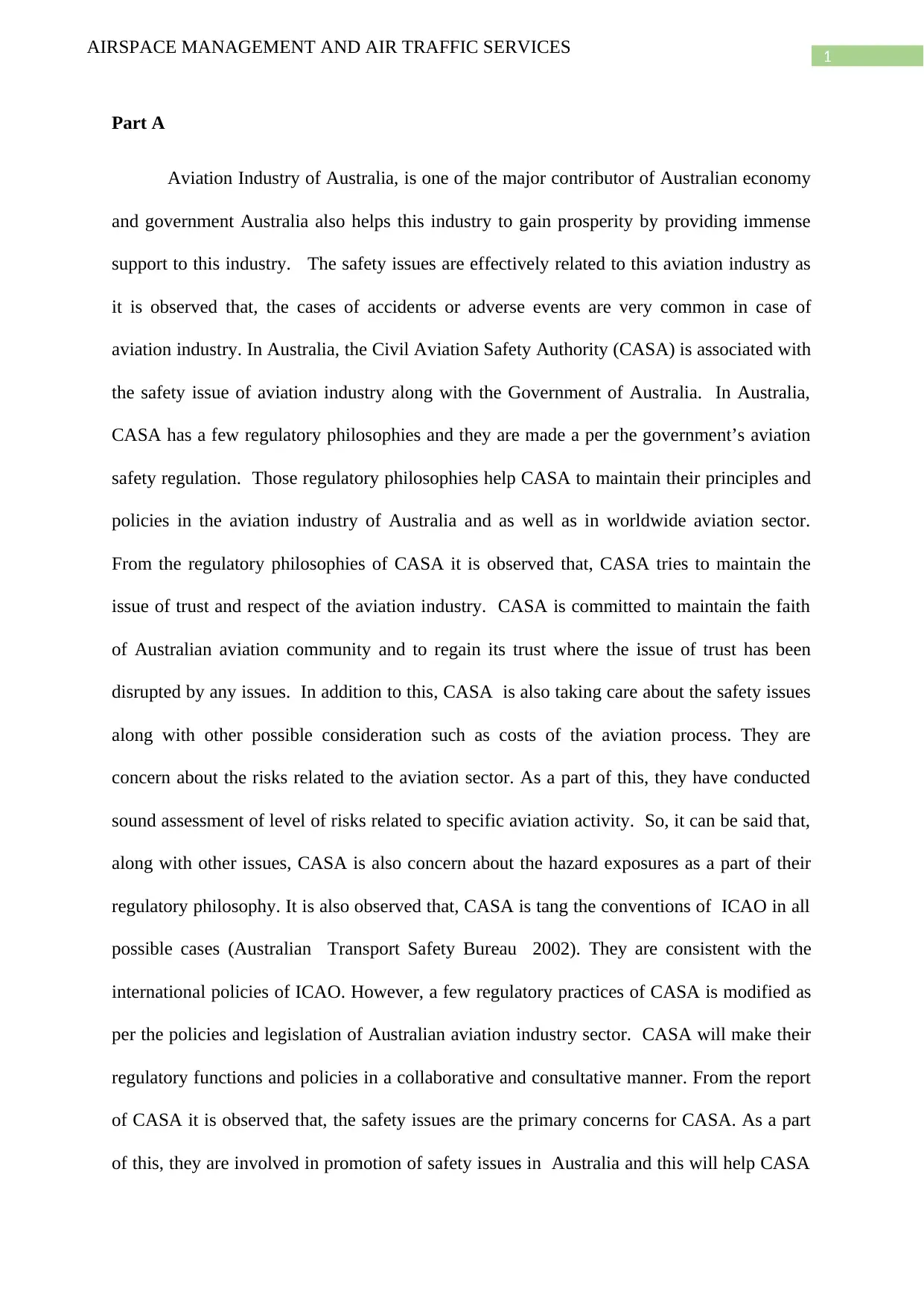
1AIRSPACE MANAGEMENT AND AIR TRAFFIC SERVICES
Part A
Aviation Industry of Australia, is one of the major contributor of Australian economy
and government Australia also helps this industry to gain prosperity by providing immense
support to this industry. The safety issues are effectively related to this aviation industry as
it is observed that, the cases of accidents or adverse events are very common in case of
aviation industry. In Australia, the Civil Aviation Safety Authority (CASA) is associated with
the safety issue of aviation industry along with the Government of Australia. In Australia,
CASA has a few regulatory philosophies and they are made a per the government’s aviation
safety regulation. Those regulatory philosophies help CASA to maintain their principles and
policies in the aviation industry of Australia and as well as in worldwide aviation sector.
From the regulatory philosophies of CASA it is observed that, CASA tries to maintain the
issue of trust and respect of the aviation industry. CASA is committed to maintain the faith
of Australian aviation community and to regain its trust where the issue of trust has been
disrupted by any issues. In addition to this, CASA is also taking care about the safety issues
along with other possible consideration such as costs of the aviation process. They are
concern about the risks related to the aviation sector. As a part of this, they have conducted
sound assessment of level of risks related to specific aviation activity. So, it can be said that,
along with other issues, CASA is also concern about the hazard exposures as a part of their
regulatory philosophy. It is also observed that, CASA is tang the conventions of ICAO in all
possible cases (Australian Transport Safety Bureau 2002). They are consistent with the
international policies of ICAO. However, a few regulatory practices of CASA is modified as
per the policies and legislation of Australian aviation industry sector. CASA will make their
regulatory functions and policies in a collaborative and consultative manner. From the report
of CASA it is observed that, the safety issues are the primary concerns for CASA. As a part
of this, they are involved in promotion of safety issues in Australia and this will help CASA
Part A
Aviation Industry of Australia, is one of the major contributor of Australian economy
and government Australia also helps this industry to gain prosperity by providing immense
support to this industry. The safety issues are effectively related to this aviation industry as
it is observed that, the cases of accidents or adverse events are very common in case of
aviation industry. In Australia, the Civil Aviation Safety Authority (CASA) is associated with
the safety issue of aviation industry along with the Government of Australia. In Australia,
CASA has a few regulatory philosophies and they are made a per the government’s aviation
safety regulation. Those regulatory philosophies help CASA to maintain their principles and
policies in the aviation industry of Australia and as well as in worldwide aviation sector.
From the regulatory philosophies of CASA it is observed that, CASA tries to maintain the
issue of trust and respect of the aviation industry. CASA is committed to maintain the faith
of Australian aviation community and to regain its trust where the issue of trust has been
disrupted by any issues. In addition to this, CASA is also taking care about the safety issues
along with other possible consideration such as costs of the aviation process. They are
concern about the risks related to the aviation sector. As a part of this, they have conducted
sound assessment of level of risks related to specific aviation activity. So, it can be said that,
along with other issues, CASA is also concern about the hazard exposures as a part of their
regulatory philosophy. It is also observed that, CASA is tang the conventions of ICAO in all
possible cases (Australian Transport Safety Bureau 2002). They are consistent with the
international policies of ICAO. However, a few regulatory practices of CASA is modified as
per the policies and legislation of Australian aviation industry sector. CASA will make their
regulatory functions and policies in a collaborative and consultative manner. From the report
of CASA it is observed that, the safety issues are the primary concerns for CASA. As a part
of this, they are involved in promotion of safety issues in Australia and this will help CASA
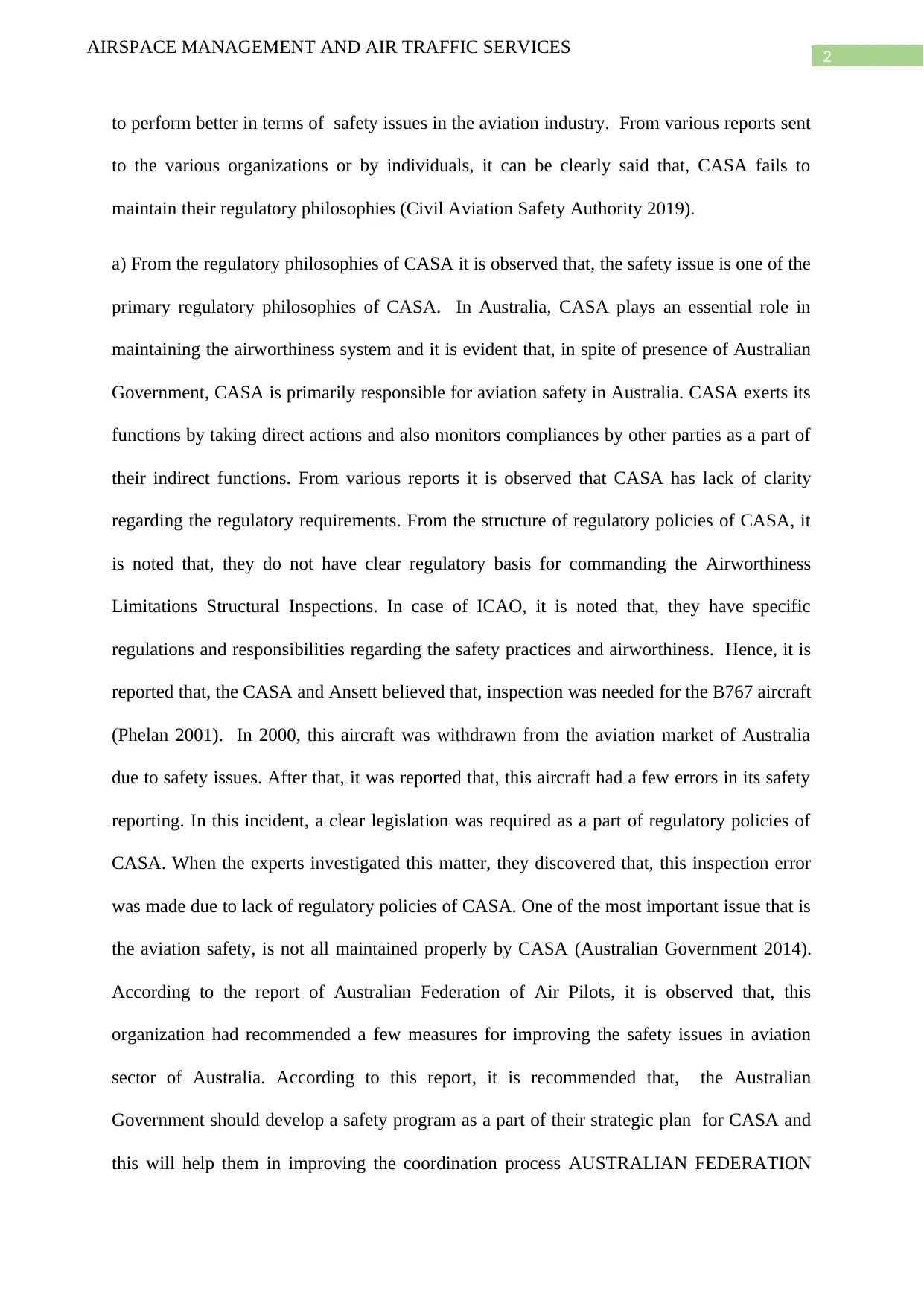
2AIRSPACE MANAGEMENT AND AIR TRAFFIC SERVICES
to perform better in terms of safety issues in the aviation industry. From various reports sent
to the various organizations or by individuals, it can be clearly said that, CASA fails to
maintain their regulatory philosophies (Civil Aviation Safety Authority 2019).
a) From the regulatory philosophies of CASA it is observed that, the safety issue is one of the
primary regulatory philosophies of CASA. In Australia, CASA plays an essential role in
maintaining the airworthiness system and it is evident that, in spite of presence of Australian
Government, CASA is primarily responsible for aviation safety in Australia. CASA exerts its
functions by taking direct actions and also monitors compliances by other parties as a part of
their indirect functions. From various reports it is observed that CASA has lack of clarity
regarding the regulatory requirements. From the structure of regulatory policies of CASA, it
is noted that, they do not have clear regulatory basis for commanding the Airworthiness
Limitations Structural Inspections. In case of ICAO, it is noted that, they have specific
regulations and responsibilities regarding the safety practices and airworthiness. Hence, it is
reported that, the CASA and Ansett believed that, inspection was needed for the B767 aircraft
(Phelan 2001). In 2000, this aircraft was withdrawn from the aviation market of Australia
due to safety issues. After that, it was reported that, this aircraft had a few errors in its safety
reporting. In this incident, a clear legislation was required as a part of regulatory policies of
CASA. When the experts investigated this matter, they discovered that, this inspection error
was made due to lack of regulatory policies of CASA. One of the most important issue that is
the aviation safety, is not all maintained properly by CASA (Australian Government 2014).
According to the report of Australian Federation of Air Pilots, it is observed that, this
organization had recommended a few measures for improving the safety issues in aviation
sector of Australia. According to this report, it is recommended that, the Australian
Government should develop a safety program as a part of their strategic plan for CASA and
this will help them in improving the coordination process AUSTRALIAN FEDERATION
to perform better in terms of safety issues in the aviation industry. From various reports sent
to the various organizations or by individuals, it can be clearly said that, CASA fails to
maintain their regulatory philosophies (Civil Aviation Safety Authority 2019).
a) From the regulatory philosophies of CASA it is observed that, the safety issue is one of the
primary regulatory philosophies of CASA. In Australia, CASA plays an essential role in
maintaining the airworthiness system and it is evident that, in spite of presence of Australian
Government, CASA is primarily responsible for aviation safety in Australia. CASA exerts its
functions by taking direct actions and also monitors compliances by other parties as a part of
their indirect functions. From various reports it is observed that CASA has lack of clarity
regarding the regulatory requirements. From the structure of regulatory policies of CASA, it
is noted that, they do not have clear regulatory basis for commanding the Airworthiness
Limitations Structural Inspections. In case of ICAO, it is noted that, they have specific
regulations and responsibilities regarding the safety practices and airworthiness. Hence, it is
reported that, the CASA and Ansett believed that, inspection was needed for the B767 aircraft
(Phelan 2001). In 2000, this aircraft was withdrawn from the aviation market of Australia
due to safety issues. After that, it was reported that, this aircraft had a few errors in its safety
reporting. In this incident, a clear legislation was required as a part of regulatory policies of
CASA. When the experts investigated this matter, they discovered that, this inspection error
was made due to lack of regulatory policies of CASA. One of the most important issue that is
the aviation safety, is not all maintained properly by CASA (Australian Government 2014).
According to the report of Australian Federation of Air Pilots, it is observed that, this
organization had recommended a few measures for improving the safety issues in aviation
sector of Australia. According to this report, it is recommended that, the Australian
Government should develop a safety program as a part of their strategic plan for CASA and
this will help them in improving the coordination process AUSTRALIAN FEDERATION
⊘ This is a preview!⊘
Do you want full access?
Subscribe today to unlock all pages.

Trusted by 1+ million students worldwide
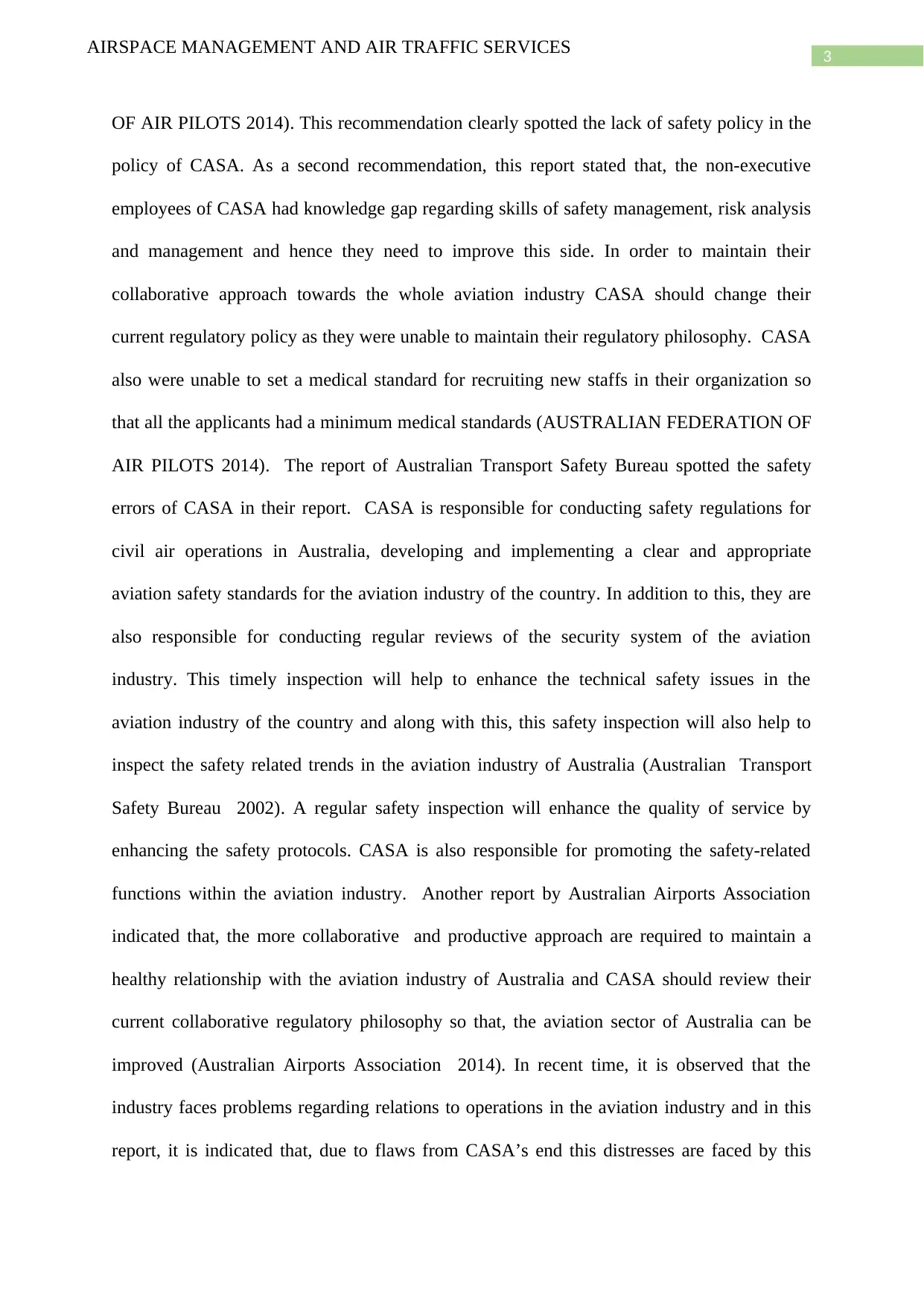
3AIRSPACE MANAGEMENT AND AIR TRAFFIC SERVICES
OF AIR PILOTS 2014). This recommendation clearly spotted the lack of safety policy in the
policy of CASA. As a second recommendation, this report stated that, the non-executive
employees of CASA had knowledge gap regarding skills of safety management, risk analysis
and management and hence they need to improve this side. In order to maintain their
collaborative approach towards the whole aviation industry CASA should change their
current regulatory policy as they were unable to maintain their regulatory philosophy. CASA
also were unable to set a medical standard for recruiting new staffs in their organization so
that all the applicants had a minimum medical standards (AUSTRALIAN FEDERATION OF
AIR PILOTS 2014). The report of Australian Transport Safety Bureau spotted the safety
errors of CASA in their report. CASA is responsible for conducting safety regulations for
civil air operations in Australia, developing and implementing a clear and appropriate
aviation safety standards for the aviation industry of the country. In addition to this, they are
also responsible for conducting regular reviews of the security system of the aviation
industry. This timely inspection will help to enhance the technical safety issues in the
aviation industry of the country and along with this, this safety inspection will also help to
inspect the safety related trends in the aviation industry of Australia (Australian Transport
Safety Bureau 2002). A regular safety inspection will enhance the quality of service by
enhancing the safety protocols. CASA is also responsible for promoting the safety-related
functions within the aviation industry. Another report by Australian Airports Association
indicated that, the more collaborative and productive approach are required to maintain a
healthy relationship with the aviation industry of Australia and CASA should review their
current collaborative regulatory philosophy so that, the aviation sector of Australia can be
improved (Australian Airports Association 2014). In recent time, it is observed that the
industry faces problems regarding relations to operations in the aviation industry and in this
report, it is indicated that, due to flaws from CASA’s end this distresses are faced by this
OF AIR PILOTS 2014). This recommendation clearly spotted the lack of safety policy in the
policy of CASA. As a second recommendation, this report stated that, the non-executive
employees of CASA had knowledge gap regarding skills of safety management, risk analysis
and management and hence they need to improve this side. In order to maintain their
collaborative approach towards the whole aviation industry CASA should change their
current regulatory policy as they were unable to maintain their regulatory philosophy. CASA
also were unable to set a medical standard for recruiting new staffs in their organization so
that all the applicants had a minimum medical standards (AUSTRALIAN FEDERATION OF
AIR PILOTS 2014). The report of Australian Transport Safety Bureau spotted the safety
errors of CASA in their report. CASA is responsible for conducting safety regulations for
civil air operations in Australia, developing and implementing a clear and appropriate
aviation safety standards for the aviation industry of the country. In addition to this, they are
also responsible for conducting regular reviews of the security system of the aviation
industry. This timely inspection will help to enhance the technical safety issues in the
aviation industry of the country and along with this, this safety inspection will also help to
inspect the safety related trends in the aviation industry of Australia (Australian Transport
Safety Bureau 2002). A regular safety inspection will enhance the quality of service by
enhancing the safety protocols. CASA is also responsible for promoting the safety-related
functions within the aviation industry. Another report by Australian Airports Association
indicated that, the more collaborative and productive approach are required to maintain a
healthy relationship with the aviation industry of Australia and CASA should review their
current collaborative regulatory philosophy so that, the aviation sector of Australia can be
improved (Australian Airports Association 2014). In recent time, it is observed that the
industry faces problems regarding relations to operations in the aviation industry and in this
report, it is indicated that, due to flaws from CASA’s end this distresses are faced by this
Paraphrase This Document
Need a fresh take? Get an instant paraphrase of this document with our AI Paraphraser
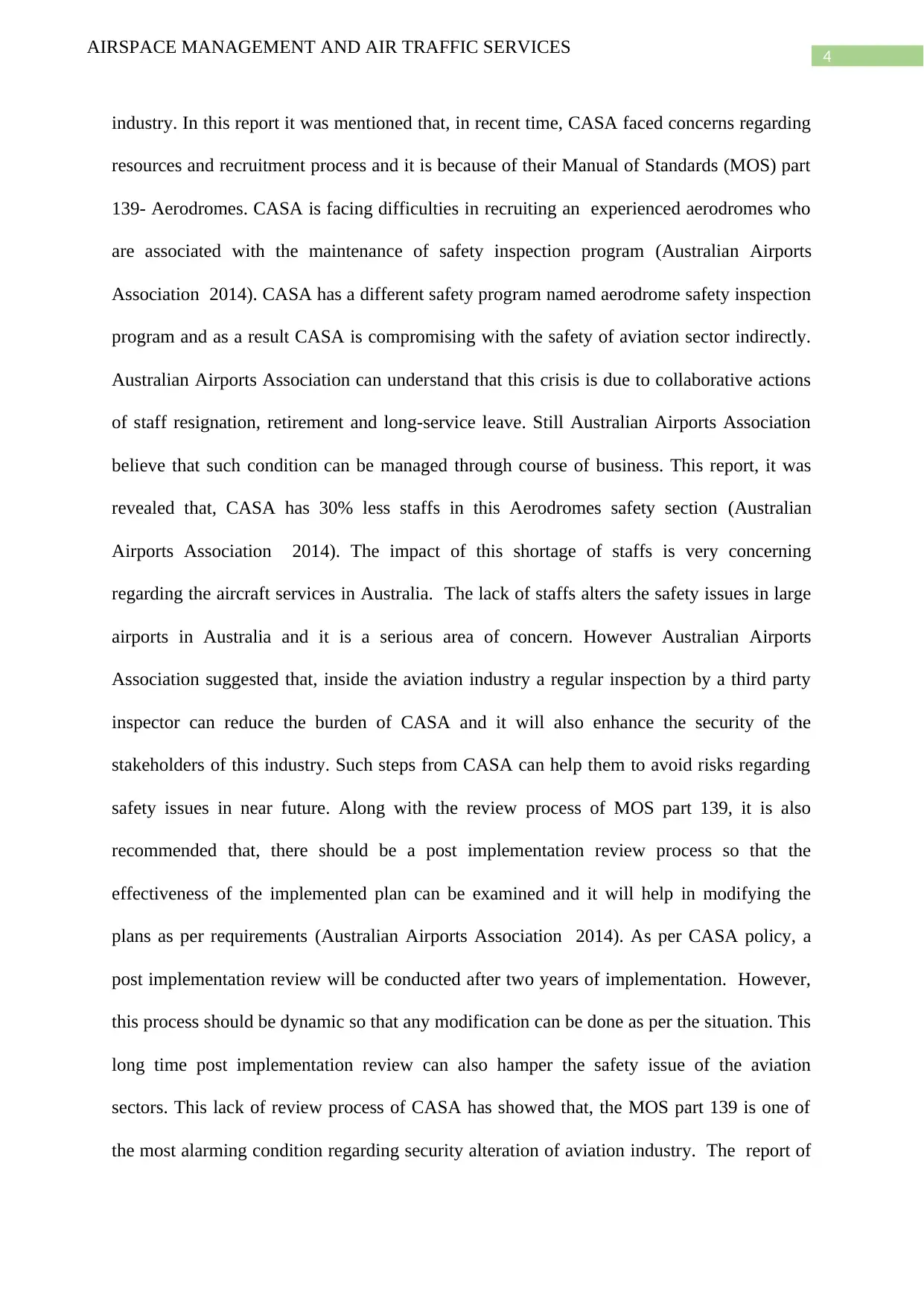
4AIRSPACE MANAGEMENT AND AIR TRAFFIC SERVICES
industry. In this report it was mentioned that, in recent time, CASA faced concerns regarding
resources and recruitment process and it is because of their Manual of Standards (MOS) part
139- Aerodromes. CASA is facing difficulties in recruiting an experienced aerodromes who
are associated with the maintenance of safety inspection program (Australian Airports
Association 2014). CASA has a different safety program named aerodrome safety inspection
program and as a result CASA is compromising with the safety of aviation sector indirectly.
Australian Airports Association can understand that this crisis is due to collaborative actions
of staff resignation, retirement and long-service leave. Still Australian Airports Association
believe that such condition can be managed through course of business. This report, it was
revealed that, CASA has 30% less staffs in this Aerodromes safety section (Australian
Airports Association 2014). The impact of this shortage of staffs is very concerning
regarding the aircraft services in Australia. The lack of staffs alters the safety issues in large
airports in Australia and it is a serious area of concern. However Australian Airports
Association suggested that, inside the aviation industry a regular inspection by a third party
inspector can reduce the burden of CASA and it will also enhance the security of the
stakeholders of this industry. Such steps from CASA can help them to avoid risks regarding
safety issues in near future. Along with the review process of MOS part 139, it is also
recommended that, there should be a post implementation review process so that the
effectiveness of the implemented plan can be examined and it will help in modifying the
plans as per requirements (Australian Airports Association 2014). As per CASA policy, a
post implementation review will be conducted after two years of implementation. However,
this process should be dynamic so that any modification can be done as per the situation. This
long time post implementation review can also hamper the safety issue of the aviation
sectors. This lack of review process of CASA has showed that, the MOS part 139 is one of
the most alarming condition regarding security alteration of aviation industry. The report of
industry. In this report it was mentioned that, in recent time, CASA faced concerns regarding
resources and recruitment process and it is because of their Manual of Standards (MOS) part
139- Aerodromes. CASA is facing difficulties in recruiting an experienced aerodromes who
are associated with the maintenance of safety inspection program (Australian Airports
Association 2014). CASA has a different safety program named aerodrome safety inspection
program and as a result CASA is compromising with the safety of aviation sector indirectly.
Australian Airports Association can understand that this crisis is due to collaborative actions
of staff resignation, retirement and long-service leave. Still Australian Airports Association
believe that such condition can be managed through course of business. This report, it was
revealed that, CASA has 30% less staffs in this Aerodromes safety section (Australian
Airports Association 2014). The impact of this shortage of staffs is very concerning
regarding the aircraft services in Australia. The lack of staffs alters the safety issues in large
airports in Australia and it is a serious area of concern. However Australian Airports
Association suggested that, inside the aviation industry a regular inspection by a third party
inspector can reduce the burden of CASA and it will also enhance the security of the
stakeholders of this industry. Such steps from CASA can help them to avoid risks regarding
safety issues in near future. Along with the review process of MOS part 139, it is also
recommended that, there should be a post implementation review process so that the
effectiveness of the implemented plan can be examined and it will help in modifying the
plans as per requirements (Australian Airports Association 2014). As per CASA policy, a
post implementation review will be conducted after two years of implementation. However,
this process should be dynamic so that any modification can be done as per the situation. This
long time post implementation review can also hamper the safety issue of the aviation
sectors. This lack of review process of CASA has showed that, the MOS part 139 is one of
the most alarming condition regarding security alteration of aviation industry. The report of

5AIRSPACE MANAGEMENT AND AIR TRAFFIC SERVICES
Australian Airports Association identified that this time consuming nature of review process
of CASA resulted in almost 100 incidents that needed emergency actions (Australian Airports
Association 2014). However, CASA stated that, they had nothing to do until more staffs will
be recruited for this post implementation review process. The report of Australian Airports
Association also identified that following any adverse incidents in airport government along
with CASA should take action immediately so that the security issues cannot be
compromised at all. The Australian Airports Association report also identified the need of
stronger reporting by CASA to the infrastructure department and Regional development
department of Australia so that CASA can operate in the aviation industry in a more
transparent way. With greater transparency, CASA may manage the safety issues more
efficiently. In addition to this, it can be said that, an improved safety management by CASA
will allow them to improve the safety outcome in the aviation industry of
Australia(Australian Airports Association 2014). Other than the safety issues, in the aviation
industry, CASA also lagged in maintaining the policies of ICAO and it is also contradicted
from their regulatory policies. The report of Australian Transport Safety Bureau showed that,
CASA also had a lot of differences regarding the regulations of ICAO. In this report, it is
reported that, a large number of differences exists in between the Australian regulation and
ICAO regulatory policies (Australian Transport Safety Bureau 2002). In 1991, after the
changes in the CASA regulatory policy, there were no formal communication between CASA
and fuel supplying authority of Australia and the authority only has right to investigate any
problem regarding quality of the fuel. This resulted in to happen many fuel related accidents
across eastern Australia in 2000 and this was reported that, those accidents took place due to
use of contaminated fluid. In 2001, ATSB released a report regarding fuel contamination and
this report suggested that, CASA had not considered fuel quality as a cause of accidents when
they stopped to oversight of aviation fuel quality. So, it can be said that the CASA is not
Australian Airports Association identified that this time consuming nature of review process
of CASA resulted in almost 100 incidents that needed emergency actions (Australian Airports
Association 2014). However, CASA stated that, they had nothing to do until more staffs will
be recruited for this post implementation review process. The report of Australian Airports
Association also identified that following any adverse incidents in airport government along
with CASA should take action immediately so that the security issues cannot be
compromised at all. The Australian Airports Association report also identified the need of
stronger reporting by CASA to the infrastructure department and Regional development
department of Australia so that CASA can operate in the aviation industry in a more
transparent way. With greater transparency, CASA may manage the safety issues more
efficiently. In addition to this, it can be said that, an improved safety management by CASA
will allow them to improve the safety outcome in the aviation industry of
Australia(Australian Airports Association 2014). Other than the safety issues, in the aviation
industry, CASA also lagged in maintaining the policies of ICAO and it is also contradicted
from their regulatory policies. The report of Australian Transport Safety Bureau showed that,
CASA also had a lot of differences regarding the regulations of ICAO. In this report, it is
reported that, a large number of differences exists in between the Australian regulation and
ICAO regulatory policies (Australian Transport Safety Bureau 2002). In 1991, after the
changes in the CASA regulatory policy, there were no formal communication between CASA
and fuel supplying authority of Australia and the authority only has right to investigate any
problem regarding quality of the fuel. This resulted in to happen many fuel related accidents
across eastern Australia in 2000 and this was reported that, those accidents took place due to
use of contaminated fluid. In 2001, ATSB released a report regarding fuel contamination and
this report suggested that, CASA had not considered fuel quality as a cause of accidents when
they stopped to oversight of aviation fuel quality. So, it can be said that the CASA is not
⊘ This is a preview!⊘
Do you want full access?
Subscribe today to unlock all pages.

Trusted by 1+ million students worldwide
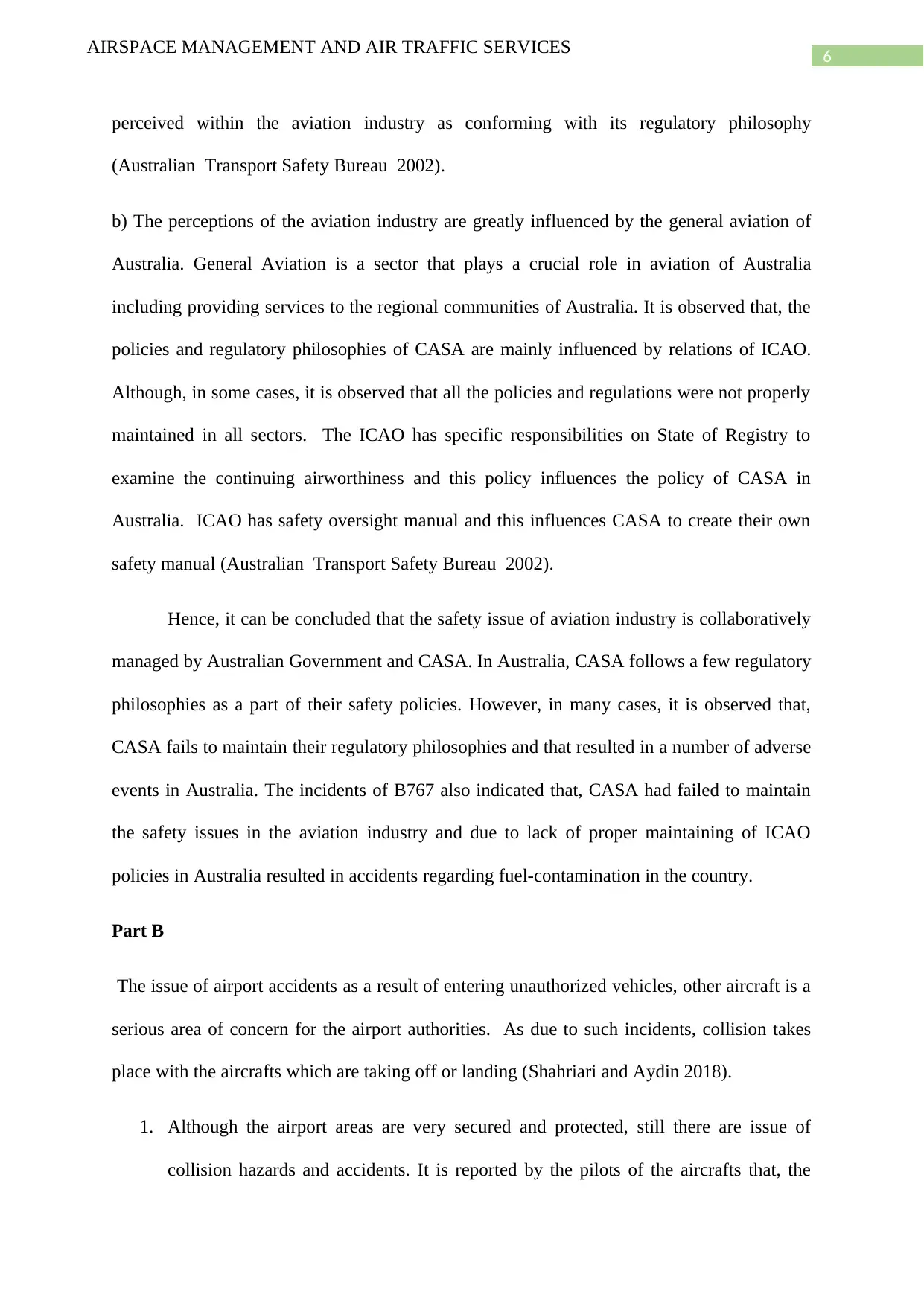
6AIRSPACE MANAGEMENT AND AIR TRAFFIC SERVICES
perceived within the aviation industry as conforming with its regulatory philosophy
(Australian Transport Safety Bureau 2002).
b) The perceptions of the aviation industry are greatly influenced by the general aviation of
Australia. General Aviation is a sector that plays a crucial role in aviation of Australia
including providing services to the regional communities of Australia. It is observed that, the
policies and regulatory philosophies of CASA are mainly influenced by relations of ICAO.
Although, in some cases, it is observed that all the policies and regulations were not properly
maintained in all sectors. The ICAO has specific responsibilities on State of Registry to
examine the continuing airworthiness and this policy influences the policy of CASA in
Australia. ICAO has safety oversight manual and this influences CASA to create their own
safety manual (Australian Transport Safety Bureau 2002).
Hence, it can be concluded that the safety issue of aviation industry is collaboratively
managed by Australian Government and CASA. In Australia, CASA follows a few regulatory
philosophies as a part of their safety policies. However, in many cases, it is observed that,
CASA fails to maintain their regulatory philosophies and that resulted in a number of adverse
events in Australia. The incidents of B767 also indicated that, CASA had failed to maintain
the safety issues in the aviation industry and due to lack of proper maintaining of ICAO
policies in Australia resulted in accidents regarding fuel-contamination in the country.
Part B
The issue of airport accidents as a result of entering unauthorized vehicles, other aircraft is a
serious area of concern for the airport authorities. As due to such incidents, collision takes
place with the aircrafts which are taking off or landing (Shahriari and Aydin 2018).
1. Although the airport areas are very secured and protected, still there are issue of
collision hazards and accidents. It is reported by the pilots of the aircrafts that, the
perceived within the aviation industry as conforming with its regulatory philosophy
(Australian Transport Safety Bureau 2002).
b) The perceptions of the aviation industry are greatly influenced by the general aviation of
Australia. General Aviation is a sector that plays a crucial role in aviation of Australia
including providing services to the regional communities of Australia. It is observed that, the
policies and regulatory philosophies of CASA are mainly influenced by relations of ICAO.
Although, in some cases, it is observed that all the policies and regulations were not properly
maintained in all sectors. The ICAO has specific responsibilities on State of Registry to
examine the continuing airworthiness and this policy influences the policy of CASA in
Australia. ICAO has safety oversight manual and this influences CASA to create their own
safety manual (Australian Transport Safety Bureau 2002).
Hence, it can be concluded that the safety issue of aviation industry is collaboratively
managed by Australian Government and CASA. In Australia, CASA follows a few regulatory
philosophies as a part of their safety policies. However, in many cases, it is observed that,
CASA fails to maintain their regulatory philosophies and that resulted in a number of adverse
events in Australia. The incidents of B767 also indicated that, CASA had failed to maintain
the safety issues in the aviation industry and due to lack of proper maintaining of ICAO
policies in Australia resulted in accidents regarding fuel-contamination in the country.
Part B
The issue of airport accidents as a result of entering unauthorized vehicles, other aircraft is a
serious area of concern for the airport authorities. As due to such incidents, collision takes
place with the aircrafts which are taking off or landing (Shahriari and Aydin 2018).
1. Although the airport areas are very secured and protected, still there are issue of
collision hazards and accidents. It is reported by the pilots of the aircrafts that, the
Paraphrase This Document
Need a fresh take? Get an instant paraphrase of this document with our AI Paraphraser
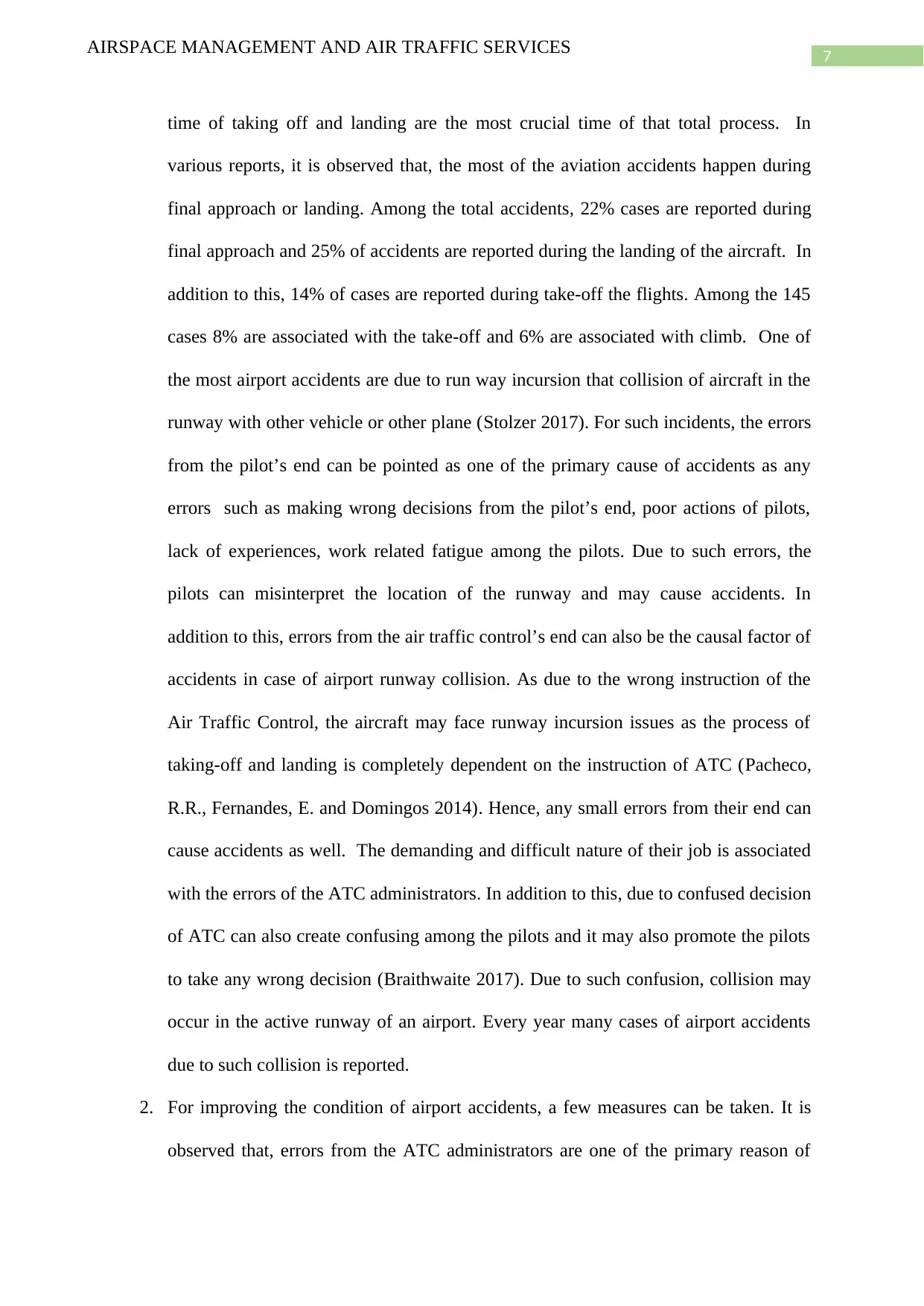
7AIRSPACE MANAGEMENT AND AIR TRAFFIC SERVICES
time of taking off and landing are the most crucial time of that total process. In
various reports, it is observed that, the most of the aviation accidents happen during
final approach or landing. Among the total accidents, 22% cases are reported during
final approach and 25% of accidents are reported during the landing of the aircraft. In
addition to this, 14% of cases are reported during take-off the flights. Among the 145
cases 8% are associated with the take-off and 6% are associated with climb. One of
the most airport accidents are due to run way incursion that collision of aircraft in the
runway with other vehicle or other plane (Stolzer 2017). For such incidents, the errors
from the pilot’s end can be pointed as one of the primary cause of accidents as any
errors such as making wrong decisions from the pilot’s end, poor actions of pilots,
lack of experiences, work related fatigue among the pilots. Due to such errors, the
pilots can misinterpret the location of the runway and may cause accidents. In
addition to this, errors from the air traffic control’s end can also be the causal factor of
accidents in case of airport runway collision. As due to the wrong instruction of the
Air Traffic Control, the aircraft may face runway incursion issues as the process of
taking-off and landing is completely dependent on the instruction of ATC (Pacheco,
R.R., Fernandes, E. and Domingos 2014). Hence, any small errors from their end can
cause accidents as well. The demanding and difficult nature of their job is associated
with the errors of the ATC administrators. In addition to this, due to confused decision
of ATC can also create confusing among the pilots and it may also promote the pilots
to take any wrong decision (Braithwaite 2017). Due to such confusion, collision may
occur in the active runway of an airport. Every year many cases of airport accidents
due to such collision is reported.
2. For improving the condition of airport accidents, a few measures can be taken. It is
observed that, errors from the ATC administrators are one of the primary reason of
time of taking off and landing are the most crucial time of that total process. In
various reports, it is observed that, the most of the aviation accidents happen during
final approach or landing. Among the total accidents, 22% cases are reported during
final approach and 25% of accidents are reported during the landing of the aircraft. In
addition to this, 14% of cases are reported during take-off the flights. Among the 145
cases 8% are associated with the take-off and 6% are associated with climb. One of
the most airport accidents are due to run way incursion that collision of aircraft in the
runway with other vehicle or other plane (Stolzer 2017). For such incidents, the errors
from the pilot’s end can be pointed as one of the primary cause of accidents as any
errors such as making wrong decisions from the pilot’s end, poor actions of pilots,
lack of experiences, work related fatigue among the pilots. Due to such errors, the
pilots can misinterpret the location of the runway and may cause accidents. In
addition to this, errors from the air traffic control’s end can also be the causal factor of
accidents in case of airport runway collision. As due to the wrong instruction of the
Air Traffic Control, the aircraft may face runway incursion issues as the process of
taking-off and landing is completely dependent on the instruction of ATC (Pacheco,
R.R., Fernandes, E. and Domingos 2014). Hence, any small errors from their end can
cause accidents as well. The demanding and difficult nature of their job is associated
with the errors of the ATC administrators. In addition to this, due to confused decision
of ATC can also create confusing among the pilots and it may also promote the pilots
to take any wrong decision (Braithwaite 2017). Due to such confusion, collision may
occur in the active runway of an airport. Every year many cases of airport accidents
due to such collision is reported.
2. For improving the condition of airport accidents, a few measures can be taken. It is
observed that, errors from the ATC administrators are one of the primary reason of
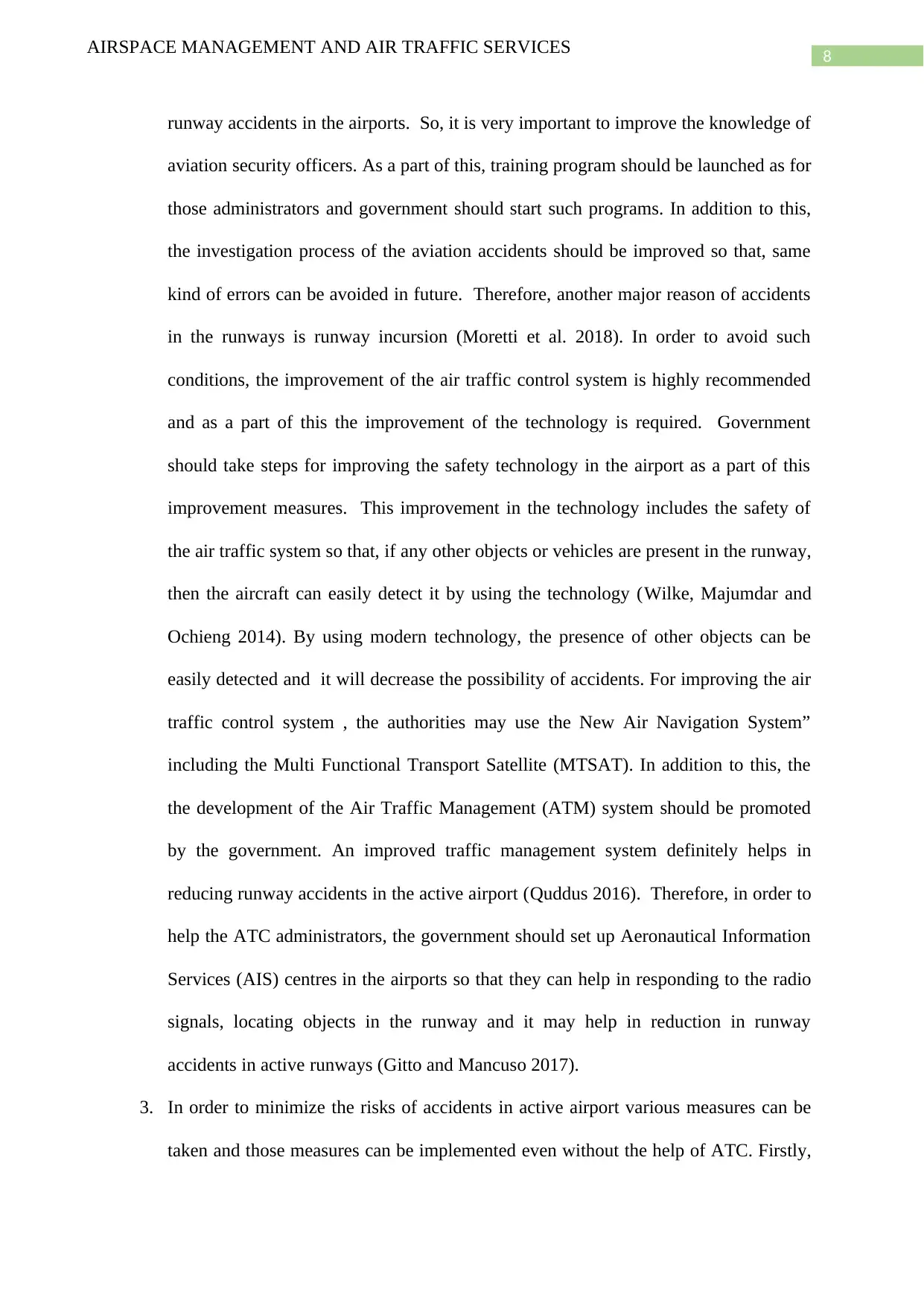
8AIRSPACE MANAGEMENT AND AIR TRAFFIC SERVICES
runway accidents in the airports. So, it is very important to improve the knowledge of
aviation security officers. As a part of this, training program should be launched as for
those administrators and government should start such programs. In addition to this,
the investigation process of the aviation accidents should be improved so that, same
kind of errors can be avoided in future. Therefore, another major reason of accidents
in the runways is runway incursion (Moretti et al. 2018). In order to avoid such
conditions, the improvement of the air traffic control system is highly recommended
and as a part of this the improvement of the technology is required. Government
should take steps for improving the safety technology in the airport as a part of this
improvement measures. This improvement in the technology includes the safety of
the air traffic system so that, if any other objects or vehicles are present in the runway,
then the aircraft can easily detect it by using the technology (Wilke, Majumdar and
Ochieng 2014). By using modern technology, the presence of other objects can be
easily detected and it will decrease the possibility of accidents. For improving the air
traffic control system , the authorities may use the New Air Navigation System”
including the Multi Functional Transport Satellite (MTSAT). In addition to this, the
the development of the Air Traffic Management (ATM) system should be promoted
by the government. An improved traffic management system definitely helps in
reducing runway accidents in the active airport (Quddus 2016). Therefore, in order to
help the ATC administrators, the government should set up Aeronautical Information
Services (AIS) centres in the airports so that they can help in responding to the radio
signals, locating objects in the runway and it may help in reduction in runway
accidents in active runways (Gitto and Mancuso 2017).
3. In order to minimize the risks of accidents in active airport various measures can be
taken and those measures can be implemented even without the help of ATC. Firstly,
runway accidents in the airports. So, it is very important to improve the knowledge of
aviation security officers. As a part of this, training program should be launched as for
those administrators and government should start such programs. In addition to this,
the investigation process of the aviation accidents should be improved so that, same
kind of errors can be avoided in future. Therefore, another major reason of accidents
in the runways is runway incursion (Moretti et al. 2018). In order to avoid such
conditions, the improvement of the air traffic control system is highly recommended
and as a part of this the improvement of the technology is required. Government
should take steps for improving the safety technology in the airport as a part of this
improvement measures. This improvement in the technology includes the safety of
the air traffic system so that, if any other objects or vehicles are present in the runway,
then the aircraft can easily detect it by using the technology (Wilke, Majumdar and
Ochieng 2014). By using modern technology, the presence of other objects can be
easily detected and it will decrease the possibility of accidents. For improving the air
traffic control system , the authorities may use the New Air Navigation System”
including the Multi Functional Transport Satellite (MTSAT). In addition to this, the
the development of the Air Traffic Management (ATM) system should be promoted
by the government. An improved traffic management system definitely helps in
reducing runway accidents in the active airport (Quddus 2016). Therefore, in order to
help the ATC administrators, the government should set up Aeronautical Information
Services (AIS) centres in the airports so that they can help in responding to the radio
signals, locating objects in the runway and it may help in reduction in runway
accidents in active runways (Gitto and Mancuso 2017).
3. In order to minimize the risks of accidents in active airport various measures can be
taken and those measures can be implemented even without the help of ATC. Firstly,
⊘ This is a preview!⊘
Do you want full access?
Subscribe today to unlock all pages.

Trusted by 1+ million students worldwide
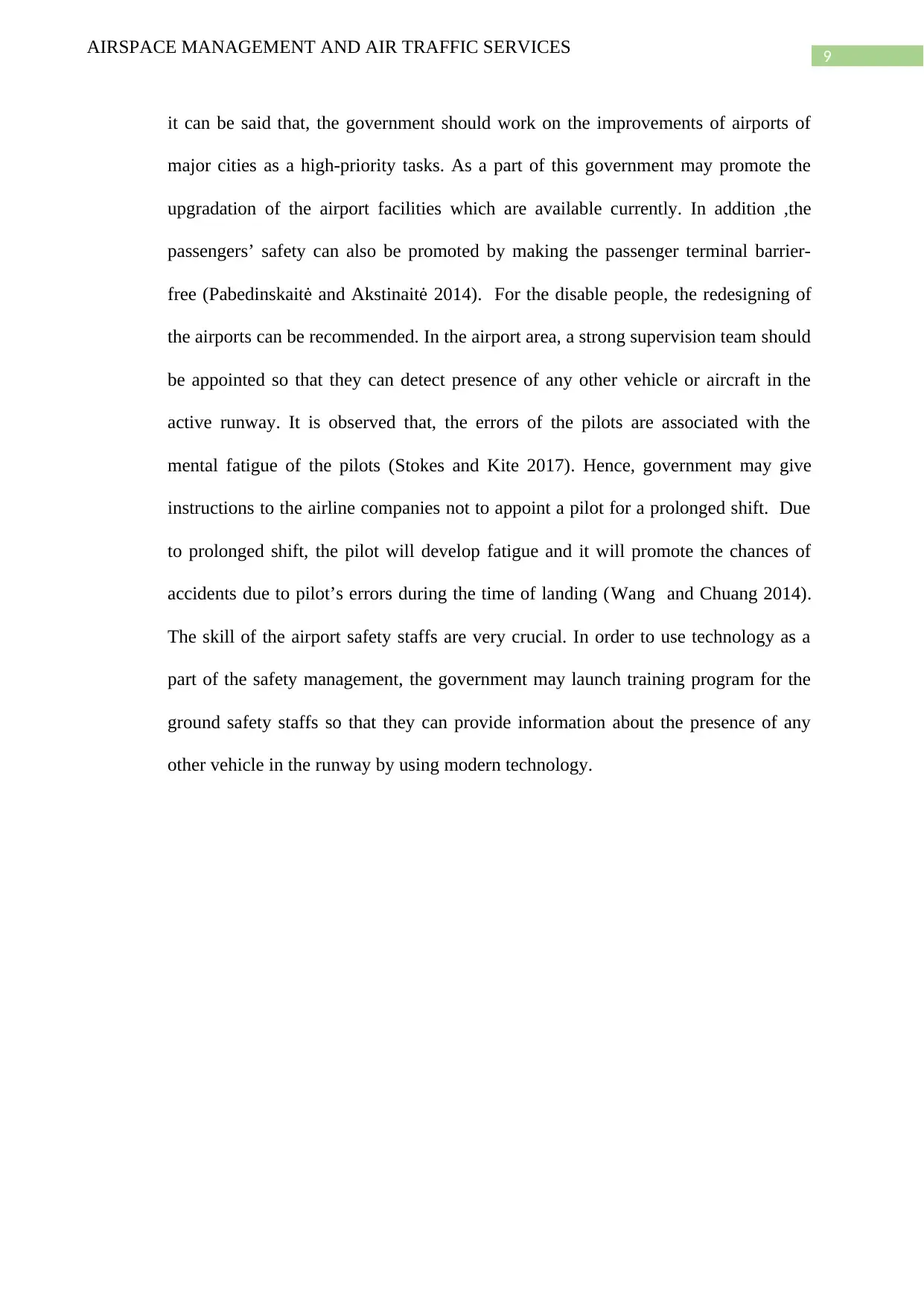
9AIRSPACE MANAGEMENT AND AIR TRAFFIC SERVICES
it can be said that, the government should work on the improvements of airports of
major cities as a high-priority tasks. As a part of this government may promote the
upgradation of the airport facilities which are available currently. In addition ,the
passengers’ safety can also be promoted by making the passenger terminal barrier-
free (Pabedinskaitė and Akstinaitė 2014). For the disable people, the redesigning of
the airports can be recommended. In the airport area, a strong supervision team should
be appointed so that they can detect presence of any other vehicle or aircraft in the
active runway. It is observed that, the errors of the pilots are associated with the
mental fatigue of the pilots (Stokes and Kite 2017). Hence, government may give
instructions to the airline companies not to appoint a pilot for a prolonged shift. Due
to prolonged shift, the pilot will develop fatigue and it will promote the chances of
accidents due to pilot’s errors during the time of landing (Wang and Chuang 2014).
The skill of the airport safety staffs are very crucial. In order to use technology as a
part of the safety management, the government may launch training program for the
ground safety staffs so that they can provide information about the presence of any
other vehicle in the runway by using modern technology.
it can be said that, the government should work on the improvements of airports of
major cities as a high-priority tasks. As a part of this government may promote the
upgradation of the airport facilities which are available currently. In addition ,the
passengers’ safety can also be promoted by making the passenger terminal barrier-
free (Pabedinskaitė and Akstinaitė 2014). For the disable people, the redesigning of
the airports can be recommended. In the airport area, a strong supervision team should
be appointed so that they can detect presence of any other vehicle or aircraft in the
active runway. It is observed that, the errors of the pilots are associated with the
mental fatigue of the pilots (Stokes and Kite 2017). Hence, government may give
instructions to the airline companies not to appoint a pilot for a prolonged shift. Due
to prolonged shift, the pilot will develop fatigue and it will promote the chances of
accidents due to pilot’s errors during the time of landing (Wang and Chuang 2014).
The skill of the airport safety staffs are very crucial. In order to use technology as a
part of the safety management, the government may launch training program for the
ground safety staffs so that they can provide information about the presence of any
other vehicle in the runway by using modern technology.
Paraphrase This Document
Need a fresh take? Get an instant paraphrase of this document with our AI Paraphraser
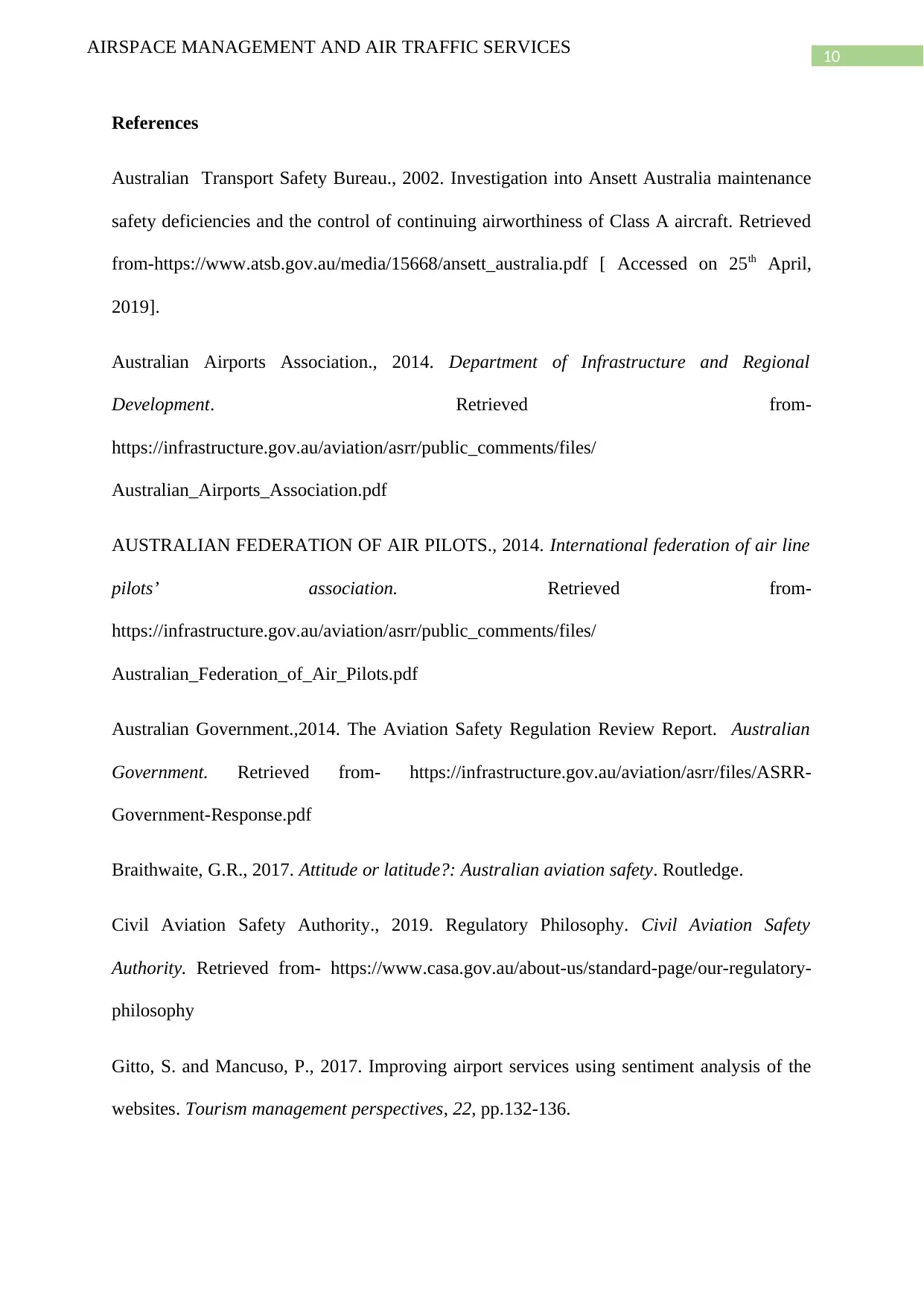
10AIRSPACE MANAGEMENT AND AIR TRAFFIC SERVICES
References
Australian Transport Safety Bureau., 2002. Investigation into Ansett Australia maintenance
safety deficiencies and the control of continuing airworthiness of Class A aircraft. Retrieved
from-https://www.atsb.gov.au/media/15668/ansett_australia.pdf [ Accessed on 25th April,
2019].
Australian Airports Association., 2014. Department of Infrastructure and Regional
Development. Retrieved from-
https://infrastructure.gov.au/aviation/asrr/public_comments/files/
Australian_Airports_Association.pdf
AUSTRALIAN FEDERATION OF AIR PILOTS., 2014. International federation of air line
pilots’ association. Retrieved from-
https://infrastructure.gov.au/aviation/asrr/public_comments/files/
Australian_Federation_of_Air_Pilots.pdf
Australian Government.,2014. The Aviation Safety Regulation Review Report. Australian
Government. Retrieved from- https://infrastructure.gov.au/aviation/asrr/files/ASRR-
Government-Response.pdf
Braithwaite, G.R., 2017. Attitude or latitude?: Australian aviation safety. Routledge.
Civil Aviation Safety Authority., 2019. Regulatory Philosophy. Civil Aviation Safety
Authority. Retrieved from- https://www.casa.gov.au/about-us/standard-page/our-regulatory-
philosophy
Gitto, S. and Mancuso, P., 2017. Improving airport services using sentiment analysis of the
websites. Tourism management perspectives, 22, pp.132-136.
References
Australian Transport Safety Bureau., 2002. Investigation into Ansett Australia maintenance
safety deficiencies and the control of continuing airworthiness of Class A aircraft. Retrieved
from-https://www.atsb.gov.au/media/15668/ansett_australia.pdf [ Accessed on 25th April,
2019].
Australian Airports Association., 2014. Department of Infrastructure and Regional
Development. Retrieved from-
https://infrastructure.gov.au/aviation/asrr/public_comments/files/
Australian_Airports_Association.pdf
AUSTRALIAN FEDERATION OF AIR PILOTS., 2014. International federation of air line
pilots’ association. Retrieved from-
https://infrastructure.gov.au/aviation/asrr/public_comments/files/
Australian_Federation_of_Air_Pilots.pdf
Australian Government.,2014. The Aviation Safety Regulation Review Report. Australian
Government. Retrieved from- https://infrastructure.gov.au/aviation/asrr/files/ASRR-
Government-Response.pdf
Braithwaite, G.R., 2017. Attitude or latitude?: Australian aviation safety. Routledge.
Civil Aviation Safety Authority., 2019. Regulatory Philosophy. Civil Aviation Safety
Authority. Retrieved from- https://www.casa.gov.au/about-us/standard-page/our-regulatory-
philosophy
Gitto, S. and Mancuso, P., 2017. Improving airport services using sentiment analysis of the
websites. Tourism management perspectives, 22, pp.132-136.

11AIRSPACE MANAGEMENT AND AIR TRAFFIC SERVICES
Isaac, A.R. and Ruitenberg, B., 2017. Air traffic control: human performance factors.
Routledge.
Moretti, L., Di Mascio, P., Nichele, S. and Cokorilo, O., 2018. Runway veer-off accidents:
Quantitative risk assessment and risk reduction measures. Safety science, 104, pp.157-163.
Oriola, A. O., & Adekunle, A. K., 2015. Assessment of runway accident hazards in Nigeria
aviation sector. International Journal for Traffic and Transport Engineering, 5(2), 82-92.
Pabedinskaitė, A. and Akstinaitė, V., 2014. Evaluation of the airport service
quality. Procedia-Social and Behavioral Sciences, 110, pp.398-409.
Pacheco, R.R., Fernandes, E. and Domingos, E.M., 2014. Airport airside safety
index. Journal of Air Transport Management, 34, pp.86-92.
Phelan, P., 2001. Maintenance saga leads to new Ansett 767 grounding. Flight Global.
Retrieved from- https://www.flightglobal.com/news/articles/maintenance-saga-leads-to-new-
ansett-767-grounding-128930/
Quddus, M., 2016. Aviation safety and security. Air Transport Management: An
international perspective, p.191.
Shahriari, M., & Aydin, M. E., 2018. Airport Runway Incursions and Safety. In International
Conference on Applied Human Factors and Ergonomics(pp. 272-285). Springer, Cham.
Stokes, A.F. and Kite, K., 2017. Flight stress: Stress, fatigue and performance in aviation.
Routledge.
Stolzer, A.J., 2017. Safety management systems in aviation. Routledge.
Isaac, A.R. and Ruitenberg, B., 2017. Air traffic control: human performance factors.
Routledge.
Moretti, L., Di Mascio, P., Nichele, S. and Cokorilo, O., 2018. Runway veer-off accidents:
Quantitative risk assessment and risk reduction measures. Safety science, 104, pp.157-163.
Oriola, A. O., & Adekunle, A. K., 2015. Assessment of runway accident hazards in Nigeria
aviation sector. International Journal for Traffic and Transport Engineering, 5(2), 82-92.
Pabedinskaitė, A. and Akstinaitė, V., 2014. Evaluation of the airport service
quality. Procedia-Social and Behavioral Sciences, 110, pp.398-409.
Pacheco, R.R., Fernandes, E. and Domingos, E.M., 2014. Airport airside safety
index. Journal of Air Transport Management, 34, pp.86-92.
Phelan, P., 2001. Maintenance saga leads to new Ansett 767 grounding. Flight Global.
Retrieved from- https://www.flightglobal.com/news/articles/maintenance-saga-leads-to-new-
ansett-767-grounding-128930/
Quddus, M., 2016. Aviation safety and security. Air Transport Management: An
international perspective, p.191.
Shahriari, M., & Aydin, M. E., 2018. Airport Runway Incursions and Safety. In International
Conference on Applied Human Factors and Ergonomics(pp. 272-285). Springer, Cham.
Stokes, A.F. and Kite, K., 2017. Flight stress: Stress, fatigue and performance in aviation.
Routledge.
Stolzer, A.J., 2017. Safety management systems in aviation. Routledge.
⊘ This is a preview!⊘
Do you want full access?
Subscribe today to unlock all pages.

Trusted by 1+ million students worldwide
1 out of 13
Related Documents
Your All-in-One AI-Powered Toolkit for Academic Success.
+13062052269
info@desklib.com
Available 24*7 on WhatsApp / Email
![[object Object]](/_next/static/media/star-bottom.7253800d.svg)
Unlock your academic potential
Copyright © 2020–2025 A2Z Services. All Rights Reserved. Developed and managed by ZUCOL.





